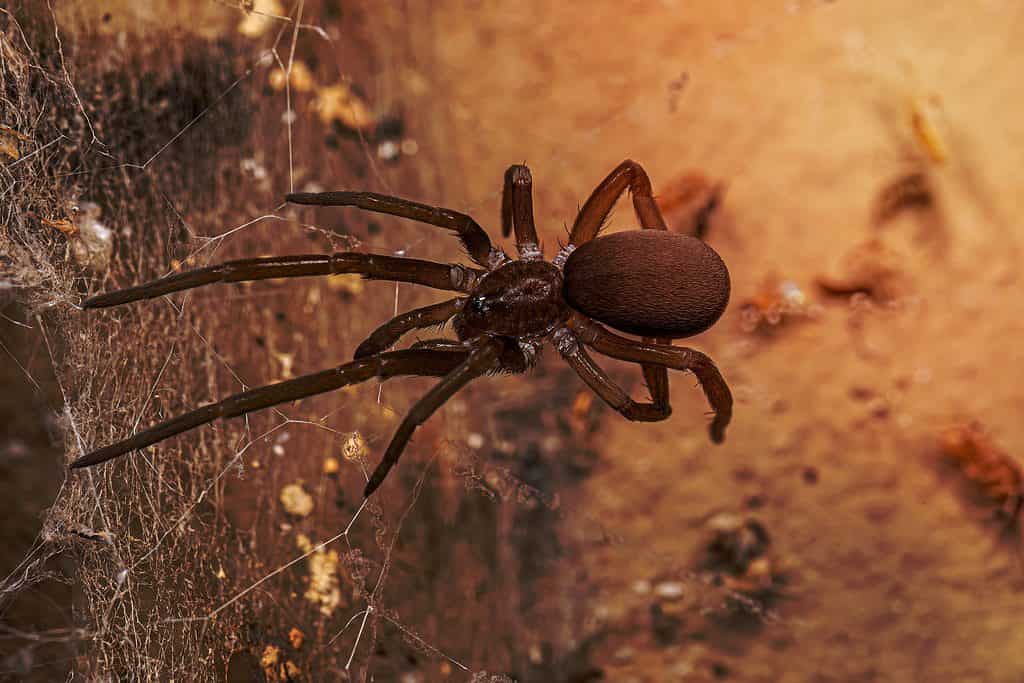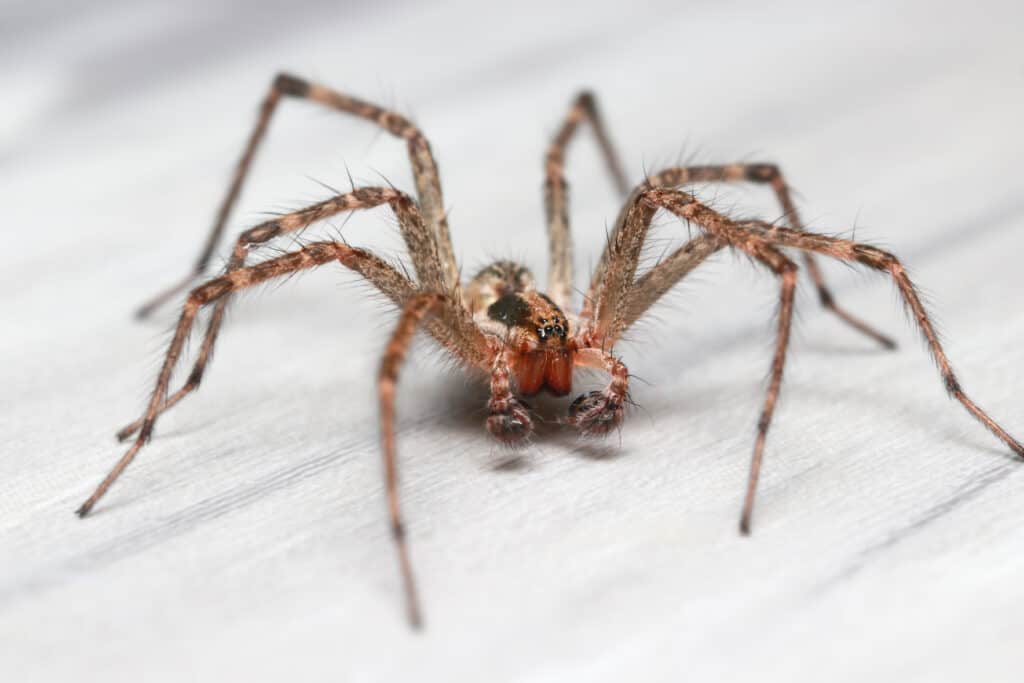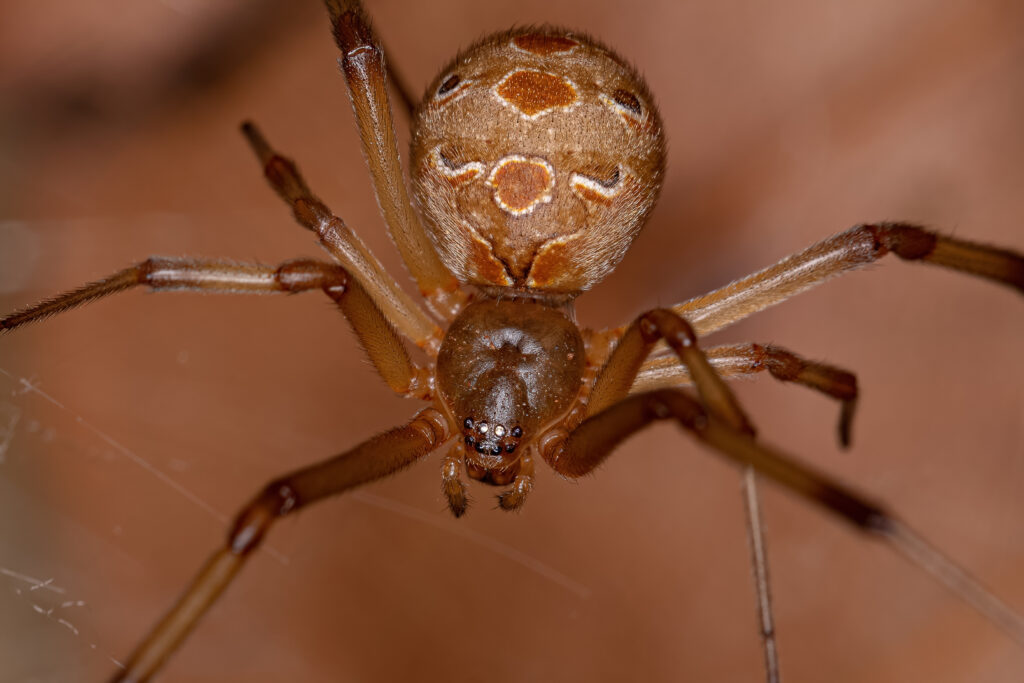Welcome to the wild world of brown spiders in Georgia! These arachnids are a fascinating and diverse group of creatures that can be found throughout the state, from forests and fields to homes and gardens. While some people might be quick to recoil at the sight of a spider, the truth is that spiders play an essential role in our ecosystem as predators of insects and other small animals.
If you’re interested in learning more about these eight-legged wonders, join us as we explore the fascinating world of brown spiders in Georgia.
1.) Crevice Spider (Kukulcania hibernalis)

©postolocanu/Shutterstock.com
The crevice spider is considered one of the most common families of spiders in Georiga. The family includes the very common southern house spider.
Appearance
Adult spiders are typically found in a plain brown or grayish-brown color and tend to be quite large. Their body is divided into two sections, with the forepart being a darker shade compared to the abdomen. The size difference between males and females is quite noticeable, with the males being much smaller and slenderer. Their body length ranges from 0.31-0.47 inches.
Due to their similar appearance, males are often mistaken for the notorious brown recluse spider.
Behavior
Crevice spiders are known scientifically as the Filistatidae family. The family is commonly referred to as crevice weavers, as they build radial webs around crevices. The females are elusive and rarely spotted as they prefer to remain stationary and only venture out to catch prey.
The males, in contrast, wander around in search of insects to feed on and females to mate with, traveling far and wide without a particular territory.
Habitat
These aptly names spiders are often found in tight spaces such as crevices. These spiders can also be commonly found in various places around the house, such as along baseboards, ceiling corners, and even in window frames.
Eating Habits
Homeowners may find the presence of these spiders advantageous since they can help control the population of common household pests, including flies, beetles, wasps, and roaches.
Venom
Despite their resemblance to the dangerous recluse spider species, crevice spiders pose no threat to humans. Their venom is not strong enough to harm us. Additionally, these spiders are generally not aggressive and are hesitant to bite.
Fun Facts
- Crevice spiders have a natural instinct to play dead when they perceive a threat.
- Female crevice spiders are larger than males, approximately double in size.
- The webs created by these spiders have a woolly texture and appear flat and tangled.
2.) Hobo Spider (Eratigena agrestis)

©SNEHIT PHOTO/Shutterstock.com
Another spider that can be commonly seen in Georiga is the hobo spider.
Appearance
The hobo spider is characterized by a brown cephalothorax, which is the front region of the body where the legs attach. The cephalothorax has darker brown markings, and the spider’s legs are also brown in color. The abdomen, which is the second region of the body, has a unique pattern of yellow markings on a gray background.
It typically measures between 1/4 to 1/2 inch in body length and has a leg span of around 1-2 inches, making it easy to spot once identified.
Behavior
While hobo spiders are often called aggressive house spiders, they are not actually aggressive in nature. Unless threatened or provoked, these spiders prefer to escape rather than confront any potential danger.
It is a common misconception that these spiders actively seek out humans to attack them. In reality, they tend to avoid human contact whenever possible.
Habitat
They are adaptable creatures and can thrive in various habitats that provide suitable conditions for tunnel formation, such as areas with cracks, holes, or crevices. They are not skilled climbers and are rarely spotted above ground level. These spiders prefer dark and damp environments.
Eating Habits
The hobo spider is recognized for its funnel-shaped web that is adept at trapping insects. These spiders remain hidden in their webs, waiting for unsuspecting insects to wander by. They feed on a wide variety of insects, including cockroaches, houseflies, and ants.
Venom
Despite its aggressive-sounding name, the hobo spider is not dangerous to humans. Their venom is not toxic, and they rarely bite humans unprovoked.
Fun Facts
- Hobo spiders are most active from August to October and when seeking web locations in the spring.
- It can be difficult to differentiate hobo spiders from other species, as they share characteristics.
- Its name is derived from its suspected mode of transportation: hitching rides with humans.
3.) Brown Widow (Latrodectus geometricus)

©iStock.com/ViniSouza128
The widow family, which also contains the infamous black widow, has a less venomous member which has become an invasive species in Georgia.
Appearance
The brown widow spider is typically smaller than the black widow species. And, of course, instead of black, these spiders are brown. Its hue may vary from a light tan to a deep brown shade. The brown widow spider has an hourglass marking on the underside of its abdomen; however, the color of the brown widow’s marking is usually bright orange or yellow.
As is the case with black widows, the females are generally larger than the males. When their legs are fully extended, females measure around half an inch in length.
Behavior
The reproductive capabilities of brown widow spiders are quite impressive, as they have the ability to produce numerous egg sacs throughout their lifetime. In fact, they can create multiple egg sacs in quick succession.
Each egg sac typically contains between 120 to 150 eggs, and a single brown widow spider can produce up to 20 egg sacs throughout its life. In comparison, many spider species only produce one egg sac before they die.
Habitat
Dark corners and crevices in man-made structures are a common habitat for this particular spider. They can often be found weaving their webs in various locations around houses, fences, barns, or any place near the ground that provides a suitable habitat.
Eating Habits
As with most spider species, the brown widow feeds on a number of insects, including crickets, mosquitoes, flies, ants, roaches, and beetles.
Venom
Although the brown widow spider’s bite may be painful and leave a small mark on the skin, it is generally considered no more harmful than any non-toxic spider. Unlike the black widow, whose bite can be fatal, a bite from the brown widow is unlikely to cause serious or prolonged symptoms.
Fun Facts
- Brown widows can be found all over the world.
- On average, males and females take 37 days and 96 days to mature, respectively.
- Males typically live an average of 108 days, while females can live up to an average of 519 days.
4.) Southeastern Wandering Spider (Anahita punctulata)

©Firdaus Khaled/Shutterstock.com
If you’re in Georgia, you’ll likely come across the southeastern wandering spider, which belongs to the Ctenidae family.
Appearance
The southeastern wandering spider, similar to other wandering spider species, boasts long legs. Their length can range between 0.20 inches and 1.56 inches, with females generally larger than males.
These spiders have a distinctive brown or tan body color and multi-jointed legs that curl upwards. Additionally, they possess a light strip that runs down the center of their carapaces and abdomens, adding to their unique appearance.
Behavior
As with other wandering spider species, the southeastern wandering spider does not spin webs to catch prey. Instead, they use a stealthy approach to attack their prey from a hidden den.
Habitat
This spider is known to make its home in various places, including burrows, on the ground, among plants, and even in fruits.
Eating Habits
The southeastern wandering spider’s diet primarily consists of insects, although they have been known to eat other spiders as well.
Venom
When provoked, the southeastern wandering spider can become defensive. Although their venom can cause localized pain and redness in the affected area, it is generally not harmful to humans.
Fun Facts
- They share a resemblance with wolf spiders.
- Their average lifespan is approximately one year.
- The transportation of bananas has been linked to introducing wandering spiders to North America.
5.) Dotted Wolf Spider (Rabidosa punctulata)

©HWall/Shutterstock.com
A member of the Lycosidae family, the dotted wolf spider is a permanent resident of Georgia.
Appearance
The dotted wolf spider has a set of four eyes above another row of smaller eyes. Females measure around 0.43 – 0.67 inches, while males are slightly larger. They have a light brown body color with a unique pattern of dark spots on the underside of the abdomen and a solid brown stripe running down the midline of the abdomen, which makes them easy to identify.
Behavior
Female dotted wolf spiders are known for their exceptional maternal instincts. They are frequently observed carrying their egg cases attached to their spinnerets. Once the spiderlings hatch, they cling to their mother’s abdomen until they are capable of surviving on their own.
Habitat
The species is primarily active at night and can be found in areas with weeds and tall grasses. Adult spiders are typically present during the fall season, with mating occurring in November.
Eating Habits
Dotted wolf spiders are predatory and mainly feed on insects and other invertebrates. However, larger females may consume small vertebrates such as amphibians and reptiles if they come across them. In addition, they are known to attack insects that are larger than themselves.
Venom
While dotted Wolf spiders are not considered deadly to humans, they can bite. Because these spiders are large, their bites can cause discomfort.
Fun Facts
- Dotted wolf spiders pursue and catch their prey in a similar manner to wolves.
- Among spider species, dotted wolf spiders possess remarkable eyesight.
- Dotted wolf spiders are nimble sprinters.
6.) Bowl and Doily Spider (Frontinella communis)

©iStock.com/ErikAgar
The bowl and doily spider belongs to the sheet weaver family.
Appearance
Bowl and doily spiders are characterized by their diminutive size and distinct appearance. These arachnids boast a notably shiny and round abdomen. The top of the spider’s abdomen typically features a deep brown or black hue, while thick vertical lines resembling inverted commas adorn the sides. Towards the lower portion of the abdomen, these markings often transition to a yellowish tint, though the precise shade may vary between specimens.
It’s worth noting that these spiders are very small, typically measuring only 0.16 inches in size.
Behavior
Bowl and doily spiders utilize a relatively intricate web-building strategy, which involves the construction of two distinct webs. An inverted, dome-shaped “bowl” web is suspended above a flat, horizontal “doily” web. The spider typically hangs from the underside of the bowl web, patiently awaiting unsuspecting prey to fall into the trap.
Habitat
They can be found inhabiting a variety of locations, including temperate forests and alpine woodlands. Despite their adaptable nature, these spiders prefer to reside outdoors rather than construct webs indoors.
Eating Habits
These spiders feed on small insects, including gnats and small flies, which become ensnared in their webs. When prey becomes trapped, the spider swiftly bites the insect and injects its venom to subdue it. Once the venom immobilizes the prey, the spider hauls it up into the “bowl” portion of its web, where it will consume the meal.
Venom
Due to their small size, Frontinella communis spiders are not capable of piercing human skin, and pose no threat to humans.
Fun Facts
- Males typically do not build webs but often cohabitate with females for long periods of time.
- These spiders have an average lifespan of up to one year.
- Frontinella communis are common in forested areas in the summer months of July and August.
The post Discover 6 Brown Spiders in Georgia appeared first on AZ Animals.
from Animal News, Facts, Rankings, and More! - AZ Animals https://ift.tt/LR3ombX